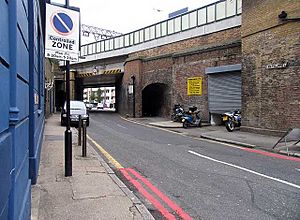Ratcliff facts for kids
Quick facts for kids Ratcliff |
|
|---|---|
 Ratcliffe Lane, near Limehouse station. |
|
| London borough | |
| Ceremonial county | Greater London |
| Region | |
| Country | England |
| Sovereign state | United Kingdom |
| Post town | LONDON |
| Postcode district | E1, E1W, E14 |
| Dialling code | 020 |
| Police | Metropolitan |
| Fire | London |
| Ambulance | London |
| EU Parliament | London |
| London Assembly | |
Ratcliff or Ratcliffe is an area in London. It's located in the London Borough of Tower Hamlets. You can find it on the north side of the River Thames. It sits between Limehouse to the east and Shadwell to the west. Today, people don't use the name Ratcliff as much as they used to.
Contents
History of Ratcliff
What's in a Name?
The name Ratcliffe comes from a small cliff that used to be there. This cliff was made of sandstone and looked red. So, the name means "Red-cliff." It stood above the marshy land around it.
Ratcliff Through the Ages
In the past, Ratcliff was known as "sailor town." It was famous for building ships. Later, from the 1300s, it became known for getting ships ready for voyages. This included fitting them out and supplying them with food.
In the 1500s, many important trips of discovery started from Ratcliff. Explorers like Hugh Willoughby and Martin Frobisher got their ships ready here. By the early 1600s, Ratcliff was the biggest village in the Stepney area. It had about 3,500 people living there.
Shipbuilding returned to Ratcliff in the 1600s. Several warships were built here for the Royal Navy. One of these was the Constant Warwick in 1645. It was one of the first ships called a frigate.
From the late 1500s, Ratcliff was also a place for different Christian groups. These groups were called non-conformists. They didn't follow the main Church of England. For example, in 1592, John Penry preached here. By 1669, about 200 Presbyterians met in a warehouse. There was also a special meeting house for Quakers. Soldiers sadly destroyed it in 1670.
Ratcliff was part of the Limehouse and Stepney areas. This changed in 1866 when it became its own separate area. From 1855, it was managed by a local board. In 1900, it became part of the Metropolitan Borough of Stepney. By the late 1800s, Ratcliff had improved a lot. It had good roads, gas lighting, and water supply.
St. James Church in Butcher Row was Ratcliff's main church. It was built in 1838. The church was damaged during the Second World War. In 1951, its area joined with St. Paul, Shadwell. Since 1948, the church site has been home to the Royal Foundation of St Katharine.
The Great Ratcliffe Fire
The Ratcliffe Fire was a huge disaster in London. It was the biggest fire between the Great Fire of London in 1666 and the Blitz in 1940. The fire happened in July 1794. A small fire accidentally set off a barge full of saltpetre. Saltpetre is a chemical that burns very easily.
The fire that followed destroyed over 400 homes. It also burned down 20 warehouses. About 1,000 people lost their homes. After the fire, tents were set up near St. Dunstan's Church. People lived there while the area was rebuilt.
Population and Area
The Ratcliff area covered about 111 acres (0.45 square kilometers). Here's how its population changed over time:
Hamlet of Ratcliffe 1801-1901
| Year | 1801 | 1811 | 1821 | 1831 | 1841 | 1851 | 1861 | 1871 | 1881 | 1891 | 1901 |
|---|---|---|---|---|---|---|---|---|---|---|---|
| Population | 5,666 | 6,998 | 6,973 | 9,741 | 11,874 | 15,212 | 16,874 | 16,131 | 16,107 | 14,928 | 14,810 |




